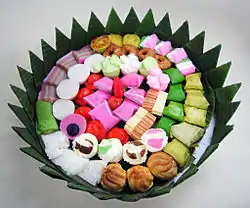Kue satu
Kue satu (in West Java and Jakarta) or kue koya (in Central and East Java) is a popular traditional kue kering (traditional cookie) of white-colored sweet mung beans powder that is crumbled when being bitten. It is commonly found as traditional cookie in Indonesia, especially in Java island. In Indonesia, this cookie is popularly served during festive occasions, such as Lebaran (Eid al Fitr), Natal (Christmas), and Imlek (Chinese new year). It is believed that the cookies derived from Chinese Peranakan traditional cookies or dry kue.
 White-colored kue satu | |
| Alternative names | Kue koya |
|---|---|
| Type | Kue kering (traditional cookie) |
| Course | Snack |
| Place of origin | Indonesia |
| Region or state | West Java, Jakarta, Central Java, Yogyakarta, East Java |
| Serving temperature | Room temperature |
| Main ingredients | Mung beans, powdered sugar, vanilla essence |
| Variations | kue koya kacang tanah (peanut) |
Ingredients and cooking method
Kue satu or kue koya is one of the simplest and easiest kue kering (traditional cookie) in Indonesian cuisine. It consists of only four ingredients; mung beans, powdered sugar, vanilla essence, and water. The mung beans are sautéed without oil until their green skins are cracked. After the skins are removed, the peeled mung beans are mashed or ground manually using mortar and pestle, or using electrical devices like a food processor or blender. The powdered mung beans are then mixed with powdered sugar, vanilla essence, and a small amount of water to form a dough. This dough is then placed into small cookie molds and baked in the oven at 150 degree Celsius heat. Afterwards, the baked cookies are aired and sun-dried for several hours before being stored in air-tight glasses or plastic cookie jars.[1]
Variants
The most common kue koya uses mung beans that created the white-colored powder. Another variant is called kue koya kacang tanah that uses common ground peanuts instead of mung beans, thus created a brown-colored kue koya.
See also
References
- "Resep Membuat Kue satu (Kue Koya) Tradisional Mudah dan Sederhana" (in Indonesian). Masak Kue. Retrieved 24 June 2015.
